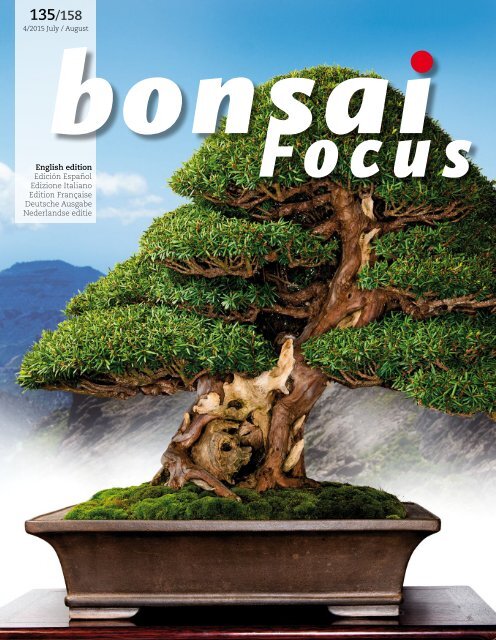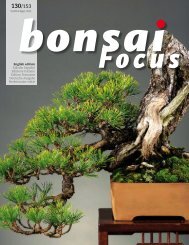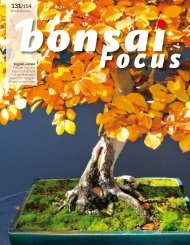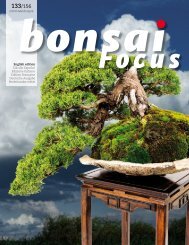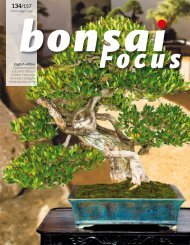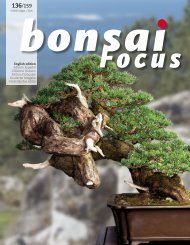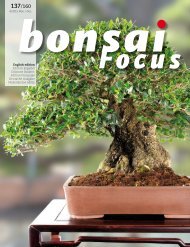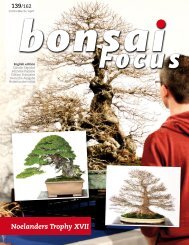BONSAI FOCUS 2015-4 EN PREVIEW
Discover how fascinating Bonsai Focus is! With informative reports and stunning photography every two months, Bonsai Focus Magazine makes you eye-witness extraordinary bonsai, magnificent stylings of famous masters, educational techniques and useful maintenance tips. Articles are often supported by exclusive and breathtaking videos.
Discover how fascinating Bonsai Focus is! With informative reports and stunning photography every two months, Bonsai Focus Magazine makes you eye-witness extraordinary bonsai, magnificent stylings of famous masters, educational techniques and useful maintenance tips. Articles are often supported by exclusive and breathtaking videos.
You also want an ePaper? Increase the reach of your titles
YUMPU automatically turns print PDFs into web optimized ePapers that Google loves.
135/158<br />
4/<strong>2015</strong> July / August<br />
English edition<br />
Edición Español<br />
Edizione Italiano<br />
Edition Française<br />
Deutsche Ausgabe<br />
Nederlandse editie
Bonsai Focus<br />
EDITORIAL<br />
3<br />
Who we are<br />
Publisher<br />
Bonsai Europe Publications<br />
Houtrustweg 96,<br />
2566 GJ The Hague<br />
The Netherlands<br />
Europe:<br />
Tel.: +31 (0)85 90 20 900<br />
Office hours: 9am - 5pm (CET)<br />
USA:<br />
Tel.:(+1) 703-738-9965<br />
Office hours: 9am - 5pm (East Coast)<br />
E-mail:<br />
info@bonsaifocus.com<br />
Website:<br />
www.bonsaifocus.com<br />
Chief Editor:<br />
Farrand Bloch<br />
editor@bonsaifocus.com<br />
Editorial staff:<br />
English edition: Ann Scutcher<br />
French edition: Patrick Bosc, Matthieu<br />
Mavridis<br />
German edition: Jörg Derlien<br />
Dutch edition: Hein-Dik Barentsen<br />
Italian edition: Erika Lakin<br />
Spanish edition: Ana Ricart<br />
Advertising & Marketing:<br />
René Rooswinkel<br />
sales@bonsaifocus.com<br />
Subscriptions & Administration:<br />
Marja Heijmink<br />
admin@bonsaifocus.com<br />
Issn UK: 1874 - 6853<br />
Issn US: 1876 - 6137<br />
Price:<br />
€ 11.95 | $ 14.95 | £ 9.95<br />
© Copyright <strong>2015</strong><br />
Bonsai Europe, world rights reserved. No<br />
part of this publication may be reproduced<br />
in any form without the written<br />
permission of the publisher.<br />
Invasion from the US<br />
Ryan Neil (US) was one of the headliners at<br />
the Nöelanders trophy in January, so it gave<br />
us the opportunity of inviting him over to our<br />
studio for a demo. But what a struggle it is<br />
to get great material for him to work on. Our<br />
saviour was Carlos van der Vaart who came<br />
up with a suitable tree. A sabina juniper, just<br />
like Ryan's last demo I know but, sabinas<br />
seem to be his favourite. He said to me that<br />
he would have many sabinas if he lived in<br />
Europe. It wasn't for that reason we decided<br />
to let him work on another sabina. For Ryan<br />
to excel you need to feed him with a really<br />
nasty task so that his skills and artistry are<br />
used to the maximum. This medium sized juniper<br />
fitted this description perfectly because,<br />
to put it bluntly, it was just plain ugly! Looking<br />
at it more closely we found it had lots of<br />
potential although viewing it for the first time<br />
it was more like a big clutter of branches with<br />
a very long 'stick' immerging from it. I had<br />
little doubt that Ryan would work it out just<br />
fine. We sent Ryan photos and were mightily<br />
relieved when he said, 'yes, let's do it'. And it<br />
proved to be the right candidate for showcasing<br />
the magical stuff Ryan is capable of. Enjoy<br />
his work on a totally 'different' sabina juniper.<br />
From one American to lots of other American<br />
contributors. It was not planned this way,<br />
but just happened and a good thing because<br />
we love to see even more American work<br />
published here in our mag. In a contribution<br />
from Randy Clark you learn how a firefighter<br />
from Florida, David Cutchin, follows his<br />
dream, working hard to make it as a full time<br />
bonsai artist. It is amazing how many western<br />
ceramists or potters make great pots for<br />
bonsai in all kinds of styles and glazes and we<br />
are happy to show the work of Sara Rayner,<br />
another American, who changed her career<br />
dramatically from general to bonsai pottery<br />
after visiting a bonsai show in the late eighties.<br />
Yet another American contribution to read<br />
comes from Aarin Packard, the new curator of<br />
the Pacific Bonsai Museum, who organizes a<br />
special event on wiring: why to wire a tree —<br />
or why not to.<br />
Reports on events, help for daily maintenance,<br />
techniques and our popular column by<br />
Tony Tickle; it's all here in this edition of your<br />
favourite magazine. Enjoy the read.<br />
Bonsai Focus has a co-operation with<br />
Kinbon magazine, Kyoto, Japan<br />
Translations:<br />
Peter Warren<br />
Farrand Bloch<br />
Chief editor
4 Bonsai Focus<br />
THIS ISSUE<br />
Our Icons<br />
Video available<br />
bonsaifocus.com<br />
Beginner<br />
Advanced<br />
On the cover<br />
Taxus cuspidata<br />
owned by Othmar Auer, Italy.<br />
Photo: Bonsai Focus Studio<br />
Scan the code<br />
with your phone<br />
Expert<br />
34<br />
6 News<br />
Arco show, Bonsai Art Museum, Japan and Michael Hagedorn<br />
8 Gallery<br />
A selection of bonsai from Japan<br />
10 Shohin with native trees<br />
Morten Albek prefers to work on native material<br />
14 Profile<br />
Laurent Darrieux is a self-taught artist<br />
10<br />
18 Let's wire<br />
Techniques to wire with pleasure<br />
22 Step by step<br />
Hiroki Miura shows us how to work with Tamarix<br />
24 Shohin<br />
How to transplant shohin conifers with Hiroki Miura<br />
30 Drifting away<br />
Using driftwood to make a natural-looking root stand<br />
62
24<br />
42<br />
34 Maintenance<br />
Get better results by partially removing the fresh new leaves<br />
42 Masterclass with Ryan Neil<br />
A small sabina juniper with lots of potential<br />
52 Club spirit, a report<br />
Louis Bourdeau reports from Geneva's Trophée des Clubs<br />
54 Suiseki: The mitsubishi stone<br />
A rare stone displayed in a rather modern way<br />
56 Mastered without a guru<br />
The pots of Sara Rayner<br />
59 Tony's Column<br />
Tony Tickle explores the influences that guide us<br />
12<br />
60 Expert opinion<br />
François Jeker on Hugo Minder's hornbeam<br />
62 Wireless<br />
Special exhibition at the Pacific Bonsai Museum<br />
by Aarin Packard<br />
66 The subtle curve<br />
Valentin Brose works on an Australian pine<br />
71 Sowing the seeds<br />
Starting bonsai from the very beginning 2: seeds<br />
74 News<br />
New bonsai book by Harry Harrington, Pots by Patricia Pas,<br />
Salvatore's Myrtle ten years on<br />
76 Firefighter goes bonsai<br />
By Randy Clark: David Cutchin shows his skills<br />
66
Bonsai Focus<br />
GALLERY 9<br />
Pinus parviflora, Cydonia, Dyosphyrus,<br />
Cryptomeria, Stewartia, Pinus parviflora<br />
Photo: Kinbon magazine, Japan<br />
Pinus parviflora, Chamenomelis<br />
Photo: Kinbon magazine, Japan
Bonsai Focus<br />
TECHNIQUE<br />
19<br />
Tools to use for wiring<br />
The minimum of tools required are a pair of wire cutters,<br />
pliers and the correct thickness of wire, either aluminium<br />
or copper<br />
A wire cutter with long<br />
legs has the advantage<br />
that you can reach<br />
deep into the foliage to<br />
remove wire<br />
Cheap jin pliers with a<br />
thin beak<br />
Stainless steel or carbon<br />
steel jin pliers with a<br />
thicker beak is a far better<br />
option, for it has superior<br />
grip on the wire<br />
A normal wire cutter suitable for<br />
cutting wires from 0.6 to 4 mm in<br />
aluminium and 0.6 to 2.75 mm in<br />
copper<br />
A small wire cutter speeds up wiring<br />
when doing detail work. You can keep the<br />
cutter in your hand while wiring; just cut<br />
the wire and continue<br />
Copper or aluminium?<br />
As a rule of thumb, conifers should be wired with copper and<br />
deciduous with aluminium. As you start learning, there is no<br />
need to be so definite. However, you should be aware that you<br />
must always use a thicker gauge of aluminium wire compared<br />
with copper. It should also be noted that once copper wire has<br />
Heavy duty<br />
A wire cutter has a limit of<br />
wire thickness that it can<br />
cope with. So for cutting<br />
thick copper wire there are<br />
big tools available, like this<br />
290 mm sized Masakuni<br />
wire cutter.<br />
been bent, it will become hard<br />
and difficult to re-bend. Aluminium<br />
on the other hand becomes<br />
weaker and more malleable.<br />
Rather than trying to wire heavy<br />
branches and create large and<br />
difficult bends from the start, it is better to concentrate<br />
on wiring secondary branches correctly and cleanly so you can<br />
arrange them to form attractive foliage pads. For beginners it's<br />
best to get over the fear of wiring by concentrating on achieving<br />
technically correct wiring in a lower risk situation. There is no<br />
way that you will be able to recreate professional wiring<br />
immediately. However, if care is taken and the<br />
work is checked for mistakes, then any<br />
small problems will soon be corrected.<br />
Use your index finger to move the wire<br />
around the branch. Don't cut the wire too<br />
short as you will need the extra length to<br />
hold it<br />
Anchoring is essential. See here<br />
how the wire is anchored around<br />
the jin on the right. Support the<br />
wire when applying it to avoid<br />
damaging the branch
52 Bonsai Focus<br />
REPORT<br />
Detail of the Bonsai Club<br />
Ticino display that won<br />
first prize<br />
Club spirit<br />
Together we are strong, battling for the best display<br />
The Trophée des Clubs is an event organized by the Bonsai Club du<br />
Léman, whose third edition was held on April 25-26 in Veyrier close<br />
to the city of Geneva<br />
Text and photography: Louis Bourdeau<br />
This event highlights collective presentation of some European bonsai clubs.<br />
14 clubs from Switzerland, Monaco and France displayed their trees in a<br />
large, bright space of 600 m². Judges were Jean-Marc Defferrard, bonsai<br />
professional from Geneva, Frederic Chenal, French professional, and Peter<br />
Warren, from the UK, a professional very well known to Bonsai Focus readers.<br />
They had to judge the displays at various levels and inspiration, but always<br />
composed in a collective spirit and a real sense of harmony.<br />
Some clubs opted for displays in the very classical Japanese style like Ticino<br />
Bonsai Club, or Club Bonsai no Seishin, with great success. Others dared to<br />
defy convention by choosing more original forms, but these were marked<br />
by a real artistic sensibility, like the Bonsai Club de Monaco, Bonsai Club du<br />
Limousin, or Bonsai Freunde Emmental.<br />
The only individual tree given an award is a juniper by Nicola<br />
Crivelli which won the Judge's Prize. The remaining seven awards<br />
all went to bonsai displays<br />
This year's winners are:<br />
Overall winner: Bonsai Club Ticino (Switzerland)<br />
Second: 'Castres Bonsai Passion (France)<br />
Third: Bonsai no Seishin (France)<br />
A great event that highlighted the club spirit and<br />
the importance of presentation and display in the<br />
art of bonsai.<br />
Detail of the display by Bonsai Club no Seishin,<br />
showing a Picea
Bonsai Focus<br />
53<br />
The next<br />
'Generation'<br />
From March 27-30, the small town of Neckargemünd,<br />
close to famous Heidelberg, was the bustling centre for a<br />
new generation of bonsai artists<br />
The second prize was awarded to the<br />
club Castres Bonsai passion for their<br />
display<br />
'Bonsaimotorworld'<br />
Road trip to Japan<br />
Text and photography: Guillaume Billaud<br />
For the second time young bonsai Masters worldwide united<br />
under the flag of Generation Bonsai, an event that celebrates the<br />
new fresh energy encircling the world. By means of Internet and<br />
social media, modern bonsai outside Japan is more prominent<br />
than ever. High artistic value, advanced techniques, creativity in<br />
unison, friendship and fun now reign among the rising artists of<br />
a new generation. Traits that ultimately will help to bring bonsai<br />
to a new level of public attention, as Michael Tran, organizer of<br />
Maybe some of you readers already know about this, but<br />
Mario Komsta has made the decision of visiting his old<br />
Master by driving to Japan by motorcycle. It's a grand tour<br />
criss-crossing many countries, but ever-energetic and<br />
adventurous Mario thinks he needs three months to arrive<br />
at his destination. Already on his way, he has made it to<br />
Esphehan, Iran. Mario still needs to drive a whole lot more<br />
miles to finally reach the nursery of Nobuichi Urushibata<br />
in Shizuoka, Japan. Follow his road trip on Facebook and<br />
see the daily videos of his adventures.<br />
www.facebook.com/pages/Bonsaimotorworld/<br />
Top left: Bjorn<br />
Bjorholm works<br />
on a Picea. Top<br />
right: The demo of<br />
Taiga Urushibata.<br />
Above: Alexandre<br />
Escudero's display<br />
the event, believes. 'The<br />
trees are great as they are,<br />
but with interesting people<br />
behind them, who display<br />
a profound lifestyle with<br />
artful trees, cooperation and fun, tied together and<br />
presented in the new media, bonsai will shine in a<br />
new light.'<br />
This year's artists Taiga Urushibata, Bjorn Bjorholm<br />
and Alexandre Escudero put their skills on display<br />
for an ever-growing crowd of bonsai enthusiasts<br />
from all over Europe, the youngest of whom are<br />
between 10 to 16 years old. Like last year Heike van<br />
Gunst contributed her passion for bonsai by her<br />
presence on stage, as moderator and translator. We'll<br />
keep you posted with news on the next 'Generation'<br />
event in 2016.
Bonsai Focus<br />
NEWS<br />
75<br />
The backyard in Manassas, Virginia, USA of Lloyd Carrera Santos<br />
The garden and black pine of Edoardo Losio from Italy<br />
Bonsai and display. . . Show us your bonsai at home<br />
We were curious to see how you display<br />
your bonsai at home. So we asked you,<br />
our readers, to show us how you enjoy<br />
your bonsai when returning home from<br />
a long day's work. Bonsai can serve as<br />
a moment of relaxation. These images<br />
show some of your garden displays. We<br />
would love to see more so keep them<br />
coming. Just send your photographs to<br />
editor@bonsaifocus.com<br />
Michael Pistello from California, USA in his garden<br />
Typically<br />
Mediterranean<br />
Salvatore<br />
at work<br />
in his old<br />
studio in<br />
Milan in<br />
2005<br />
The tree<br />
at the<br />
start of<br />
2000<br />
A flash back in time, to February 2005, 10<br />
years ago and Salvatore Liporace is still in<br />
his old studio right in the centre of Milan.<br />
We did a photo demo on a not so familiar<br />
tree, the Myrtus, a typically Mediterranean<br />
tree which grows in the coastal regions of<br />
Southern Italy. He was assisted by Olivier<br />
Barreau, who was one of his students at<br />
that time. The work began by dealing with<br />
the large wounds caused by removing<br />
large trunks. Wiring of this evergreen tree<br />
is easy when achieving a good branch<br />
set-up; it's a question of clip and grow<br />
to improve its ramification. It blossoms<br />
in spring with tiny white flowers and it<br />
shows berries in autumn. It has matured<br />
immensely over these ten years.<br />
The tree just after<br />
repotting in spring<br />
2005<br />
The blossoming<br />
Myrtle in <strong>2015</strong>,<br />
now owned by<br />
Xavi Massanet
80 Bonsai Focus<br />
STYLING<br />
Foliage reduction<br />
Foliage reduction on this juniper is accomplished in two stages. The first<br />
before any wire is applied to the tree and the second during the actual<br />
application of wire. In the first stage green growth occurring on inner<br />
branches is reduced. This will allow for better visualization of the branch<br />
structure and create pathways for the application of wire in the second<br />
stage. This is accomplished by cutting as well as fingertip pinching. The<br />
objective is to eliminate downward growing branches; sucker growth<br />
and growth in the crotches of branch intersections. The three photos on<br />
the left illustrate this process. Lusher growth at the tips of the branches<br />
will be allowed to remain and will be reduced as the process of detail<br />
wiring begins and branchlets are moved into their final positions.<br />
Foliage reducing before wiring<br />
After wiring<br />
Branches are wired, sometimes even up to the tips and positioned. As the<br />
process proceeds it allows for the meticulous layering of growth on each<br />
foliage pad and ensures that all branches receive optimal sun exposure<br />
and air movement. It is these two elements which help ensure healthy<br />
foliage growth and copious back budding<br />
Repotted, the<br />
final result<br />
Initially, the wiring process proceeds<br />
as it normally would with any bonsai.<br />
However, David’s technique for detail<br />
wiring takes a slightly different approach.<br />
It involves trimming foliage tips and then<br />
Detail of the<br />
wired lower<br />
right branch<br />
applying detail wire (sometimes as fine as<br />
a thread) at the same time
Bonsai Focus<br />
NEXT ISSUE<br />
81<br />
Preview<br />
Issue 136/159 September/October<br />
TECHNIQUE<br />
Not just bending, but bending using advanced techniques. Learn<br />
how to bend to the maximum without damage.<br />
WORKSHOP<br />
Accent plantings are becoming ever more popular. We bring you<br />
a 'how to' or 'how not to' workshop with these small plants.<br />
MASTERCLASS<br />
Bjorn Bjorholm harnesses every bit of power he can muster to<br />
style a massive yew.<br />
NATIVE<br />
Walter Pall promotes the natural<br />
style of native trees, this time it's<br />
an old hornbeam.
For the complete<br />
Subscribe now!!<br />
You are just<br />
one click away!!


